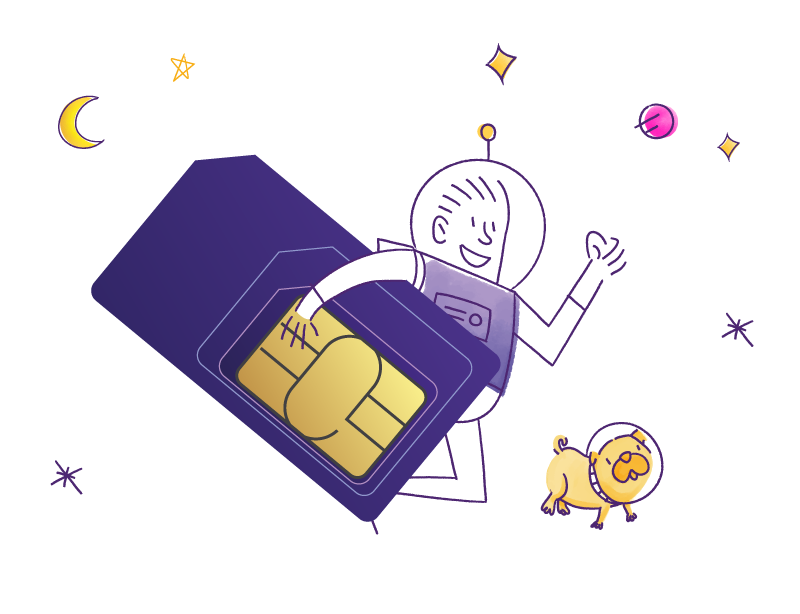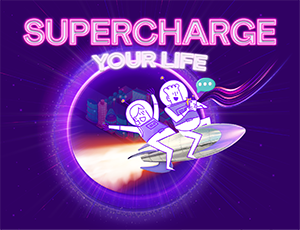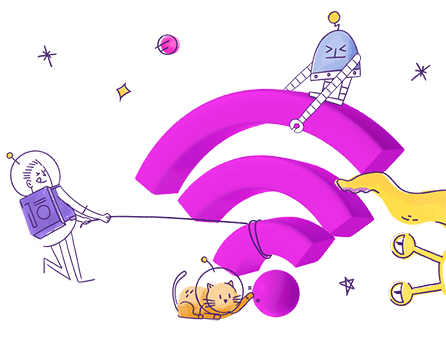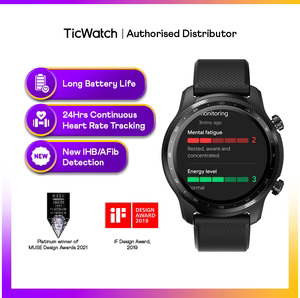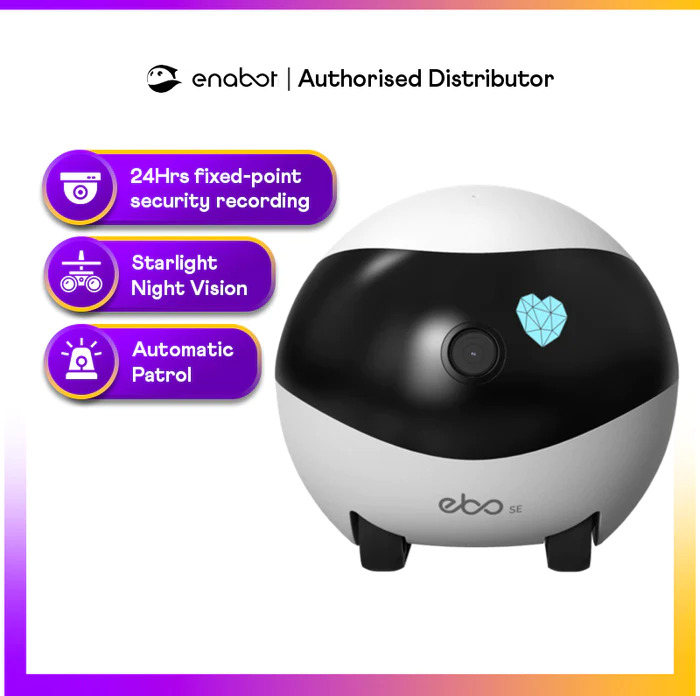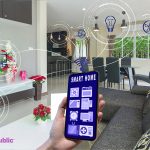- April 6, 2023
- MyRepublic Mobile
An Overview of 5G and Mobile Technology Generations
- What is 5G and How Does It Relate to My Mobile Service?
- Who Invented 5G? What Makes a New Generation of Mobile Technology?
- Did 1G exist? How Did Mobile Technology Evolve
- How is 5G Better than 4G?
- Standalone (SA) 5G, Non-Standalone (NSA) 5G and “True 5G”
5G Technology and its Limitations
- Spectrum and Radio Frequencies
- High Band or Millimetre Wave (mmWave)
- Mid Band or Sub-6GHz
- Low Band
- 5G Massive MIMO and Beamforming
The State of 5G in Singapore
- When Did 5G Launch in Singapore? What 5G Does Singapore Have?
- How’s 5G Coverage in Singapore?
- How Fast is 5G in Singapore?
- Which Mobile Operators Offer 5G Services in Singapore?
Things to Consider When Getting a 5G Plan
An Overview of 5G and Mobile Technology Generations
What is 5G and How Does It Relate to My Mobile Service?
5G refers to the fifth generation (that’s the “G”) of cellular or mobile wireless networking technology, with the previous generations also named accordingly: 1G, 2G, 3G, 4G, etc.
So if you’re using a mobile device to connect to the internet or receive telephone calls wirelessly, you’re using mobile communication technologies that fall into one of these generational groupings.
Each “G” is defined by specific technologies or technology standards. For example, you may have heard of the term “4G LTE” or seen it in the corner of your phone screen. That tells you that you are using fourth generation mobile technology and specifically the main technology standard under 4G which is Long Term Evolution (LTE).
For 5G, the main technology standard is New Radio (NR) so you might come across the term “5G NR” like we have with “4G LTE” . If you’re wondering what radio technology has to do with your mobile communication, cellular networks basically use radio waves at particular frequencies to communicate.
Each new generation of wireless cellular technology has also been defined by significant improvements in performance, such as bandwidth and network capacity. For example, the theoretical maximum download speed of 4G LTE is 150Mbps while 3G only could reach a maximum of 7.2Mbps.
Who Invented 5G? What Makes a New Generation of Mobile Technology?
No one person or company owns or invented 5G. Companies and people all over the world are developing the technologies that make up 5G.
That said, 5G and its predecessor generations have specific definitions and are globally recognised: there are industry standards organisations that decide and maintain the global standards and specifications that make up each “G”.
The leading group developing and maintaining standards for 5G is the 3rd Generation Partnership Project (3GPP), an industry consortium involving mobile operators and vendors. For instance, 3GPP has been responsible for establishing NR as the standard for its radio access technology. They have also worked to define standards for previous generations.
Another leading authority defining standards for 5G and previous generations is the International Telecommunications Union (ITU), which is an agency of the United Nations specialising in information and communication technologies.
Did 1G exist? How Did Mobile Technology Evolve?
Although obsolete today, 1G or the first generation of mobile telecommunications did exist, although we didn’t really label it as such until 2G came about to mark the transformational shift from one generation to another.
1G cellular technologies started in the 1980s and were analogue based i.e. not digital. While 1G could only deliver voice calls, the ability to make and receive mobile telephone calls was already a definitive step forward.
2G, the second generation of mobile networks that started in the 1990s, would begin the use of digital technologies and limited mobile data services, starting with SMS text messages and eventually expanding to Multimedia Messaging Service (MMS).
In the 2000s, the third generation, 3G, introduced significant improvements over what 2G delivered: better voice quality and higher data transfer rates, the latter of which was particularly important to the introduction of smartphones and mobile modems.
Starting in the 2010s, 4G introduced much higher data-transfer rates (as mentioned above, theoretically about 20 times faster than what 3G could), improvements in latency, and location-based services that have enabled the launch of apps and services like mobile video, mobile gaming, ride-sharing and food delivery.
As you may have observed, a new mobile generation seems to emerge on average every 10 years or so, which puts us on track with how 5G is quickly emerging in the 2020s. And with how much 4G transformed not just how we use mobile apps but also the makeup of the internet landscape over a decade, it’s easy to understand why people would be very excited over the possibilities of 5G.
How is 5G Better than 4G?
5G is designed to be better compared to 4G for consumers in 3 primary ways: massively faster data speeds, much lower latency, and greater bandwidth for many connected devices.
We’ll first quickly talk about the theoretical benefits of 5G i.e. what 5G technology can achieve under ideal conditions as there are many factors that can affect actual real-time performance, such as what device you’re using, your location and carrier’s network coverage.
Additionally, we’re still in the relative early years of 5G. As previous generations of mobile technology have shown, how effectively we apply 5G technologies and their benefits should evolve and improve over the years.
1. Much Faster Download Speeds
As a consumer, if you’ve heard about 5G, you’ve probably heard about how much faster 5G is supposed to be compared to 4G. From a technology perspective and under ideal conditions, 5G is said to offer download speeds of up to 10Gbps, which is several times faster than even the highest theoretical speeds of the latest 4G LTE Advanced Pro technology.
Now while it’s highly unlikely we’ll hit such data peak rates in the real world, reports from mobile network users on today’s level of 5G technology still show impressive performance in mobile download speeds.
According to Opensignal, in 2022 the average global uplift from 4G to 5G for download speeds was 408.9%. In other words, 5G on average was reported to be 4 times faster based on data collected worldwide.
In Singapore, 5G was recorded to be an incredible 5.6 times faster than 4G when it came to download speeds in 2022, with the average Singapore 5G download speed clocking at 266.3Mbps.
2. Near-Zero Latency
While still to do with speed, latency isn’t quite the same thing as download data rates. Latency is specifically about how much time is needed for a packet of data to go to its destination and back, which is why it’s measured in milliseconds (ms). The smaller the latency, the better as it basically means a faster response time.
For example, 100ms is a tenth of a second: an incredibly small unit of time but enough to have a negative impact on your online gaming or certain network applications.
The goal of 5G is to get latency to 1ms or less, enabling practically “real-time” communication. For comparison, 4G networks have a theoretical limit of 10ms, with real-world results clocking in at 30ms- 70ms. Even current generation Wi-Fi networks typically deliver 20ms-40ms. For 5G today, you could expect an average latency of around 10ms.
In the industry, this time-critical benefit is known as Ultra-Reliable Low Latency Communication (URLLC). URLLC is particularly helpful for enterprise applications involving the Internet of Things (IoT) and machine-to-machine (M2M) communication.
IoT is basically all about networked devices (that’s the “things”) embedded with sensors, software and other technologies that are connected with each other or the internet and exchanging data. Smart devices like smart home systems, smart car systems, fitness tracking watches or personal medical devices like pacemakers all fall under IoT.
Any remote or automatic process involving precise movement would benefit from having highly reliable, near-instant response times. For example, in smart factories, robots have to perform operations exactly as requested. And in autonomous vehicle networks, you’d want a smart vehicle to receive and react to new information as soon as possible.
3. Greater Capacity for Connected Devices
If you find your mobile connection much slower during certain times of the day or when you’re in a crowded area, network congestion is probably to blame.
And it’s a widespread issue: A 2019 OpenSignal report showed how 4G speeds can vary significantly throughout the day. Even Singapore, considered a top-performing country, showed a speed gap of 13Mbps between the fastest and slowest hours, which is a significant number considering our highest speed was only 54.7Mbps.
5G is designed to be much better at handling many devices at a single location, targeting each device intelligently with high precision as opposed transmitting over the whole area.
This capacity upgrade won’t just benefit mobile phone users, it promises to greatly enable IoT applications as well. If you think about it, IoT involves many tiny devices that need wireless connectivity. A smart city with an interconnected ecosystem needs a network that can handle an enormous number of online IoT devices.
In theory, 5G mobile broadband should be able to handle as much as 1 million devices per square kilometre, compared to around 2,000 devices under 4G. This enabling of high connection density is also known in the industry as Massive Machine-Type Communications (mMTC).
4. Other 5G Benefits: Power Efficiency and Networking Slicing
Besides improvements in these three key areas, 5G looks to deliver other benefits as well.
In addition to better latency and network capacity enabling better IoT applications, 5G technologies are also looking to lower or improve the energy consumption efficiency for IoT devices: good news considering how the battery maintenance and replacement for billions of IoT devices will not be easy.
Under 5G, there is also Narrowband IoT, which is a low power wide area technology ideal for IoT applications in remote areas. There have even been developments where IoT devices can harvest energy from 5G networks, promising a new generation of self-powered sensors.
Another notable aspect of 5G that has garnered significant interest among businesses is network slicing. Network slicing is basically the ability of 5G networks to function as multiple separate networks at the same time (like you’re “slicing” one network into different parts), with each slice optimised for a specific application or secured for a particular customer.
Standalone (SA) 5G, Non-Standalone (NSA) 5G and “True 5G”
It’s not easy to draw a clear division between one generation of wireless cellular technology and another. Building, deploying and testing network architecture and new technologies take time and resources on the scale of years and millions of dollars.
Standalone (SA) 5G refers to a mobile network that is designed and built to 5G specifications from end to end, from a 5G network core to the radio communication equipment. As SA 5G is not dependent on any legacy architecture, it’s said to stand on its own (hence “standalone”).
In comparison, a Non-Standalone (NSA) 5G network makes use of an existing 4G network core but uses 5G radio systems to deploy a 5G network. To do this, virtualisation software is used to make a virtual version of the 4G core that can support 5G services.
The term “True 5G” has been used to market 5G SA products but 5G NSA is still technically 5G. It’s more accurate to think of it as another version of 5G: 3GPP, the leading standards authority on 5G we mentioned above, has specified 5G core standards for both NSA and SA 5G.
1. From 5G NSA to 5G SA
The first 5G rollouts were NSA deployments as they were the most cost-effective and easiest to implement, leveraging existing 4G infrastructure. NSA architecture has essentially allowed 5G services to launch sooner in many places than they would have otherwise.
Many telecom operators view NSA as a path to SA, with a plan to shift after they’ve built up the required 5G infrastructure. There are also operators like Reliance Jio in India who have opted to deploy purely 5G SA.
That said, while it’s generally agreed that the industry should move to 5G SA one day, the timeline for many operators to make that shift is rather uncertain due to a number of commercial factors and technical challenges.
For context, as of end-2022, only a total of 39 operators worldwide have commercially launched 5G SA networks. This is in contrast to over 200 5G NSA networks worldwide and over 700 LTE networks that could implement 5G SA.
2. Is 5G SA better than 5G NSA?
In short, yes. While 5G NSA networks can provide higher speed mobile broadband to consumers (compared to 4G LTE), the general consensus is that SA remains the future of 5G and it’s with SA that 5G can reach full potential.
For example, you would need 5G SA to deliver the benefits of very low latencies and increased network capacity i.e. URLLC and mMTC. 5G SA is also needed for end-to-end edge computing.
Additionally, 5G SA has shown better performance including greater network capacity and faster data rates. A 2002 Rootmetrics article found T-Mobile’s SA 5G median download speed to be 2x faster than its NSA counterpart.
5G Technology and its Limitations
This section gets a little bit more technical as it explains the key technologies behind 5G. While 5G has definite benefits, a broad understanding of how 5G works will hopefully give you a better idea of why 5G has certain limitations and why it may be some time before we fully leave 4G behind.
Spectrum and Radio Frequencies
As mentioned briefly before, cellular or mobile networks basically run on radio waves, which is why we have terms like the new 5G New Radio (NR) global standard.
Radio waves have different frequencies and within the context of telecommunications, spectrum is used to refer to the spectrum of radio frequencies allocated to telecom operators for mobile services and communications.
Each country’s government or regulatory authority is typically responsible for managing and issuing licences for that country’s spectrum. In Singapore for instance, we have the Infocomm Media Development Authority (IMDA) who manages how, when and what spectrum goes to which local operator.
5G is more complicated than 4G or 3G because it uses a much wider range of frequencies as well as its own combination of different technologies and techniques.
High Band or Millimetre Wave (mmWave)
To achieve its very high data transmission speeds and ultra-low latency, 5G takes advantage of “millimetre waves” or mmWaves. These mmWaves have extremely short wavelengths as the shorter the wavelength, the higher the frequency.
mmWaves specifically refer to high-frequency radio waves above 24GHz. They are also sometimes referred to as high bands or the high-band radio spectrum.
The issue with these high frequency signals is that while they are capable of delivering much more data at impressive speeds, they can’t travel far or penetrate obstacles (such as walls and windows) as effectively as lower frequency signals.
If you’ve ever set up a dual-band Wi-Fi router in your home, you may be familiar with how you have the option of 2.4GHz and 5GHz Wi-Fi networks. This captures this trade-off on a smaller scale: the higher frequency 5GHz offers better speeds and can handle more devices but the 2.4Ghz offers better coverage and range.
It would not be possible, for instance, to receive a mmWave signal a couple of blocks away from a cell tower if there was something blocking line-of-sight to your mobile device. As such, it can take many mmWave cell towers to cover a small area versus lower frequencies needing just one, making it much more expensive and complex to roll out mmWave connectivity.
Mid Band or Sub-6GHz
Sub-6GHz 5G uses radio frequencies that lie between 1GHz and 6GHz on the radio spectrum (hence the “sub”). These frequencies are similar to what previous generations like 4G LTE have been using, with telecom operators either repurposing 4G LTE bands or using adjacent ones for 5G networks.
While these sub-6GHz frequencies won’t achieve the incredible download speeds or latency performance of mmWave 5G, they still outperform 4G and support the other benefits of 5G.
Today, sub-6GHz frequencies are commonly used together with mmWave in 5G networks to provide coverage over large areas with mmWave 5G cell sites focused in dense urban areas where human traffic and usage is highest.
Low Band
5G also includes technologies that use the low-band part of the spectrum, specifically frequencies below 1GHz.
As you might infer from what we’ve explained about high-band 5G, low-band 5G provides the best widespread coverage but the slowest data transmission speeds for 5G. That said, low-band 5G is slightly faster than 4G, about 20%.
In Singapore you probably won’t hear much talk about low-band 5G as this technology sees the best use in countries with large stretches of land and rural communities given how low-band signals can cover large distances. In other words, low-band 5G is ideal for providing internet connectivity in places where it may not have been practical or reliable before.
5G Massive MIMO and Beamforming
Given the range limitations of mmWave 5G, 5G technologies such as Massive MIMO (Multiple-Input, Multiple-Output) with beamforming help optimise overall 5G network coverage and performance. These are some of the key technologies in 5G networks.
MIMO (Multiple-Input, Multiple-Output) basically refers to the use of multiple antennas to receive and transmit data, thereby enhancing connectivity and speed. MIMO has been used in 4G and wireless communications for a long time now but with 5G we get an extension of it, which is Massive MIMO.
Beamforming, as its name suggests, is about focusing signal power into certain directions (the “beams”) more than others to improve the received signal quality while reducing interference elsewhere. Imagine using a flashlight to direct light in a beam as opposed to filling the whole area with diffused light.
Compared to regular MIMO, Massive MIMO adds even more antennas (one could say a “massive” number of antennas) to a mobile base station and brings beamforming techniques to MIMO.
The large array of antennas of a Massive MIMO system essentially produces “3D beamforming”, transmitting signals from the cell station directly to the intended mobile device. This ultimately results in a more efficient network with greater capacity and better connectivity for the user.
The State of 5G in Singapore
When Did 5G Launch in Singapore? What 5G Does Singapore Have?
Back in 2016, Singapore’s IMDA was already planning for 5G and their first 5G consultation paper was published in 2017, setting out use cases and spectrum requirements for 5G across the low-band, mid-band and high-band ranges.
In 2020, spectrum for 5G networks was awarded by the IMDA with the stated goal of at least two nationwide 5G SA networks being deployed by 2025, starting with coverage for half of Singapore by end-2022.
To note, unlike other countries who sought to roll out 5G services as soon as possible using NSA, Singapore sought to aim straight at deploying SA 5G. This has meant that while Singapore is a bit behind some countries like China and South Korea in debuting 5G, the country is set to be a forerunner in SA advancements.
Why did Singapore go directly for SA 5G? The IMDA understands SA networks are needed to deliver full-fledged 5G capabilities and there was also the consideration of how much of Singapore already has widespread access to 1Gbps fibre broadband and 4G LTE. Unlike some other countries, Singapore does not really need 5G fixed-wireless access (where 5G can replace fixed broadband and Wi-Fi) and the nation’s 5G policy is therefore more focused on supporting innovation.
Singapore’s big three Mobile Network Operators (MNOs) are among the 39 operators that have commercially launched 5G SA networks as of end-2022, with all three having launched 5G SA networks in 2021.
To be clear, Singapore MNOs did start with launching with 5G NSA services first before transitioning to SA: consumers could get access to 5G plans on NSA in 2020 before 5G SA services were available in 2021. Considering global trends, it’s been a relatively speedy journey to 5G SA for Singapore as a city-state.
How’s 5G Coverage in Singapore?
Despite disruptions from a global pandemic, Singapore is ahead of the schedule set by the IMDA for nationwide SA 5G coverage by 2025. We have also certainly met the other deadline of 5G coverage for at least half of Singapore by end-2022.
In 2022, MNO Singtel announced they achieved SA 5G coverage for over 95% of Singapore. Other leading MNO StarHub has achieved 95% outdoor coverage for its 5G services (plus many indoor locations like shopping malls) although it comprises a mix of SA and NSA networks. In late-2022, third biggest operator M1 stated that its 5G SA network has reached 90% of Singapore.
To be clear, geographical coverage isn’t the same as population coverage as people do not reside uniformly across the country. So while 5G hasn’t exactly reached 100% of Singapore’s territory, “95%” has been described as countrywide coverage.
Singapore telecom operators are also expected to continue expanding and optimising 5G network coverage islandwide. In a couple of years, exactly 100% coverage across the country seems likely.
How Fast is 5G in Singapore?
Expected 5G speeds is always a tricky question to answer. While 5G technologies improve performance, the exact speed you get is still subject to a variety of factors such as what mobile device you’re using, signal strength, interference from the environment, network congestion and so on.
If you recall, 5G networks also run on different frequency bands with mmWave 5G offering the greatest data throughput and network bandwidth but having more limited range. In other words, to achieve the very best 5G speeds, you need to be in range of a mmWave 5G cell and these aren’t widely available.
Most of the time, Singapore users using 5G will be on a 5G mid-band network, which provide better speeds than 4G but nowhere near hyped-about data rates some may expect.
Perhaps the best idea of Singapore’s 5G performance comes from a mid-2022 Opensignal report showing the average Singapore 5G download speed at 266.3Mbps.
For context, the average global 5G download speed was around 184Mbps and the highest average 5G download speed in the world as of mid-2022 is 453Mbps.
Which Mobile Operators Offer 5G Services in Singapore?
Things to Consider When Getting a 5G Plan
Should you get a 5G mobile plan in Singapore? If you’re already on 5G, perhaps you’re wondering if you made the right choice. The answer will of course be subjective, depending on factors like your budget and mobile usage habits.
Here are a number things you should consider before signing up for a 5G plan and answers to some common questions.
What Do I Need to Get 5G in Singapore?
The first thing you’d need would be a 5G compatible phone or mobile device to connect to the 5G network with. In Singapore, considering that most 5G networks here are already SA, you’ll need one that is 5G SA capable.
To note, a device that is 5G NSA compatible may not work with 5G SA so be sure to check for that specifically. As of mid-2022, 88% of 5G devices were said to support 5G SA and the percentage is likely higher now, but it isn’t 100%.
Besides that, the process of signing up for a 5G mobile plan today is practically the same as signing up for any 4G mobile plan in Singapore. If you’re already on a 4G plan, you won’t even need a new SIM card, your service provider should be able to upgrade your service plan digitally to 5G.
How Much More Expensive is 5G?
Given the highly competitive market of mobile offerings in Singapore, SA 5G mobile plans have become increasingly affordable and accessible to consumers.
While more expensive compared to the lowest-cost 4G plans, you can get a no-contract SIM-only SA 5G mobile plan with 100GB data at S$19.95 (including free caller ID and 1,200 minutes of talk time).
In short, if your monthly budget for a mobile plan is around the S$20 mark, you can find options for a 5G SA plan in Singapore.
You may also need to factor in the cost of upgrading your phone to a 5G SA-compatible model if you don’t have one. If your phone isn’t working or you’re prepared for a phone upgrade already, this may be a non-issue.
Now you don’t have to get the latest phone or the most premium models to get one that is 5G SA-compatible. A number of more budget-friendly 5G phones already support 5G SA such as the Samsung Galaxy A33 5G, Moto G51 5G, and the iPhone SE (3rd gen).
If you already have a relatively new 5G phone but aren’t sure if it’s SA compatible, industry experts say for 5G phone models, it’s a matter of a software update to upgrade a 5G phone from NSA to SA support. As such, it’s likely more 5G phones will support SA soon.
Are There Health Risks with 5G?
Does 5G Use More Battery?
At the moment, the practical answer is yes, but how much depends on a few factors.
Under ideal conditions, 5G can actually save power. Assuming your usage habits don’t change and you’re downloading the same amount of data as before, the faster speeds of 5G means it takes less time for your phone to download data, giving your phone battery more time to rest.
In other words, if it takes 5G a few seconds to download a video, your phone would use less battery than it would have on 4G taking a minute to get that same video.
However, if you were to use 5G for the same period of time as 4G, 5G would generally consume more power.
There’s a 2022 WSJ article that points to a battery life difference of roughly 20% if one were to continuously stream a Youtube video for 10 hours. This isn’t behaviour that’s accurate to real-life of course (unless you really like watching 10-hour Youtube footage non-stop) so the difference for a normal user will probably be much less.
The folks at ViserMark did some testing also in 2022 using more realistic use cases and noted only a 10% difference between 4G and 5G battery usage.
If you’ve experienced much more serious battery drain on your phone, it’s probably because of two reasons. The first goes back to SA and NSA 5G networks. Depending on how your carrier has set up its NSA network to use 4G LTE and 5G together, having your phone connected to multiple networks at the same time can drain battery faster.
The second reason is coverage: if 5G coverage is poor or very inconsistent, your phone can use more battery trying to hang onto a weak signal or search for a better connection. Phones do the same on 4G/3G as well but because 4G networks are so prevalent today, this dropping off and signal hunting seldom happens.
In another round of testing, ViserMark found that weak 5G radio signals did result in a greater drain on battery life.
If you have an iPhone, there is a smart setting to help save battery that lets your phone automatically choose which mobile network performs best: under cellular data options, enable “5G Auto” to have your iPhone switch automatically to LTE when it detects that 5G isn’t providing a better performance or if you’re not using a lot of mobile data.
Overall, it also helps to keep in mind that 5G isn’t the only factor when it comes to consuming your phone’s battery. For example, the brightness of your screen and location services can have a big impact.
Is 5G Better for Gaming?
Is 5G Worth It in Singapore?
In 2023, getting 5G is more worthwhile than it’s ever been before given how 5G SA networks have rolled out for most of Singapore and 5G mobile plans have reached new attractive price points.
That said, everyone has different priorities so whether to get a 5G mobile plan will depend on your lifestyle, your budget and how much you value certain conveniences.
If you don’t have a 5G phone and don’t plan to upgrade it soon, then it makes sense to wait until you get a new 5G phone as that’s the bulk of the costs involved even for a mid-range model.
If you spend a lot of time outdoors and regularly rely on your 4G connection or public Wi-Fi to stream online content or game online, you’ll get more out of 5G.
Regardless, it looks like 5G–or 5G SA to be exact–is the future for consumers and businesses. While much of the buzz is around potential enterprise applications, consumers can already start to experience some of the improvements 5G offers in terms of faster mobile broadband and these benefits are set to continually expand and improve.

